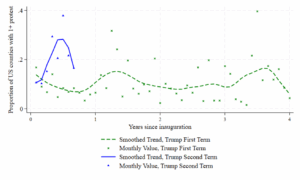Protests in 2025 have reached a wider swath of the United States than at any other point on record. And the geographic reach of protest activity—the share of U.S. counties hosting at least one event—has remained remarkably high throughout the year.
Figure 1 displays the proportion of US counties that hosted at least one protest in each month of Trump’s first and second terms (depicted by the green x and blue triangle marks, respectively). The green trend line shows the moving average during Trump’s first term, and the blue line shows the moving average so far during Trump’s second term.
Figure 1: Proportion of US Counties with at Least One Protest, by Month

The largest monthly jumps of protest counties occurred in spring 2018, with the Enough Walkouts and the March for Our Lives in the month of March and the Walkout for Gun Control in April, and then again in June 2020, during the nationwide Black Lives Matter protests near the end of Trump’s first term. During the summer of 2020, demonstrations took place in just under 40 percent of all counties, during what was probably the broadest mobilization in US history up to that point.
But June 2025 came close to matching those historic levels, largely due to the No Kings mobilizations on June 14, with protests in nearly 38 percent of counties nationwide. Moreover, in 2025 protests have also expanded the movement’s footprint into new areas, even after the No Kings events of June. The cumulative number of counties that have ever hosted a protest has been climbing steadily since 2017, with noticeable surges in 2018 and 2020. A similar surge appears to be underway in 2025, pushing the cumulative share of protest-hosting counties well above 60 percent by June.
What’s most striking and novel, however, is the persistence of activity in 2025. The first eight months of the year have seen more sustained and geographically widespread protest than any comparable stretch in Trump’s first term—including the early waves of resistance in 2017 and the mass mobilizations of 2020. Protests occurred in at least 20% of US counties for four consecutive months in 2025–something we never observed during Trump’s first term. In short, the movement is not just continuing to spread into previously unrepresented parts of the country, but also maintaining its geographic reach.